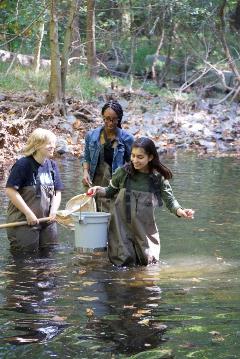Zach Moss, Save Our Streams Coordinator
Each time I conduct a Save Our Streams (SOS) training, I start by asking each participant to introduce themselves, sharing with the group who they are and why they care about clean water. The diversity in answers is one of my favorite parts of any training: the participants always turn out to come from different walks of life, from anglers to natural resource specialists to students. They value clean water for its wildlife benefits or for its importance to public health or for the recreational opportunities it provides, but they all agree on one thing: clean water is important to us all!
The Save Our Streams water quality monitoring program helps people connect around their common understanding that we all need clean water, equipping volunteer water stewards with the ability to create local change to build and strengthen communities. It all starts at the initial training, which can range in size from five to twenty-five people. No matter who’s in the class, my goal as a trainer is to empower each volunteer to realize that anybody can be a scientist. You don’t need a fancy title or years of formal education and experience to perform meaningful science that benefits your community. Students leave our trainings as confident citizen-scientists, ready to be champions for clean water by collecting water quality data and sharing it with their local decision-makers.
The Save Our Streams water quality monitoring program is about so much more than just recording numbers on data sheets. Our citizen-scientists are also passionate leaders, forward-thinking problem-solvers, and engaged community members.
As SOS volunteers travel to streams to study water quality, we encourage them to always bring other people with them. This is partially for safety reasons, but it also helps our water monitors get the most out of their experience by enjoying the social benefits of citizen-based water quality monitoring. Monitoring with others becomes a time to share stories, make memories, meet new friends, and be part of something larger than oneself. Humans are meant to be together in community, and they are meant to spend time outside. Save Our Streams provides a perfect opportunity for people to be outdoors, as a community, taking action together for their community.
I was able to enjoy that opportunity myself by taking part in the Polk County Snapshot, a twice-yearly event to monitor 70 stream sites in central Iowa on the same day. The day started off at the Des Moines Ikes' chapter house, where I met up with several dozen other volunteer monitors. Soon I was teamed up with a retired teacher and a retired chemistry lab supervisor, and the three of us – who had never met before – headed out to gather data from our three assigned stream sites.
By the end of the day, we had recorded our findings about nitrate, dissolved oxygen, turbidity, chloride, and other characteristics of our stream sites, and made a valuable contribution to Polk County's effort to compare stream health more accurately by studying many locations at the same time and under the same weather conditions. We had also learned from each other, traded stories, shared our backgrounds, made networking connections, and stirred something in our souls.
Through being part of Polk County's communal monitoring effort, I connected with two local groups that later invited me to speak to their members about SOS. My two new monitoring buddies benefited from the experience too. The chemistry lab supervisor, who was brand-new to stream monitoring, said he had learned a lot about water quality testing. The teacher, a long-time water quality advocate, was glad to know that as some stream monitoring programs fade away, others like SOS are picking up the slack. We all came out with new friends, a better understanding of our community, and a deeper appreciation of our natural resources.

People want to know what's going on with the waters they swim in, paddle on, or get their drinking water from. Water quality monitoring doesn't just produce data for professional resource managers – it tells us important information about the waterways we use ourselves. For this reason, water quality monitoring can be a fun, engaging, and meaningful activity for groups that already spend time together by the water!
There are countless examples of groups all across the country using the SOS program. A paddling group in Iowa monitors the streams they float down. A group of students in Virginia helped restore a badly degraded stream near their school, then studied the water quality in the stream to see whether their work had made a difference. And a group of dedicated Ikes in Minnesota teamed up with the National Trout Center and Winona State University to monitor multiple sites in an area recently affected by a fish kill. These groups are already organized, and SOS monitoring complements what they’re already interested in: clean water, community improvement, and natural resource conservation.
Our rigorous training and quality assurance protocols ensure that SOS monitoring produces reliable data, but Save Our Streams is about so much more than just recording numbers on data sheets. Our citizen-scientists are also passionate leaders, forward-thinking problem-solvers, and engaged community members. They care about other people, and they enjoy being outdoors together in the pursuit of clean water for all.
If you are already a stream monitor, we are all grateful for you and the work you’re doing! If you have have trained in stream monitoring but don't have a buddy to go out with, we can match you with an SOS team in your area. And, if you have not yet joined the stream monitoring community, we can't wait to welcome you. Request an SOS training now.
Learn more about Save Our Streams
Cover photo by Gregg Petersen. Inner image by Bill Ferzoco.